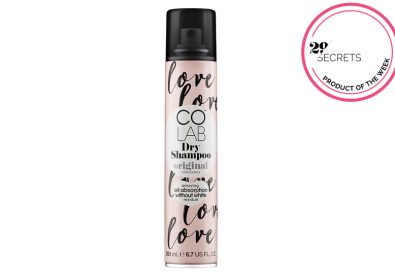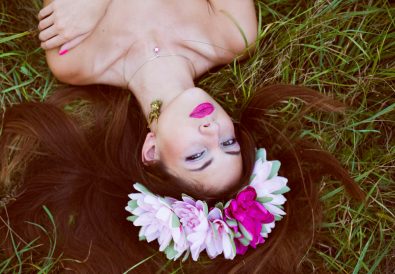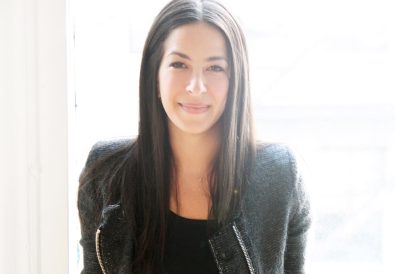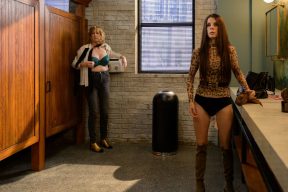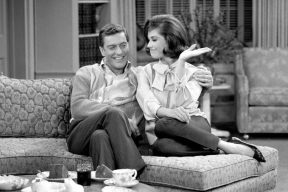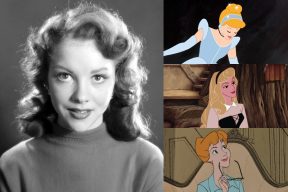For the past few years, makeup artist Derrick Rutledge has held the #1 spot on Oprah Winfrey's beauty speed dial. We can't blame her: Rutledge's brushes have graced the faces of some seriously famous clientele, from American first lady Michelle Obama to soul singer Patti Labelle. Most recently, Rutledge took on his greatest challenge yet, transforming Oprah's character in Lee Daniels' The Butler from a 30-year-old housewife in the mid-1950s to a 90-year-old grandmother in 2008.
We sat down with Rutledge to get the deets on movie makeup magic, Oprah's behind-the-scenes personality and his very own hair, skin and makeup line, OOH Lifestyle. Plus, our darker skinned beauties will rejoice: Rutledge fills us in on the woes of ashy foundation and explains how to achieve an all-over glow simply by looking in the mirror.
First, tell us a little bit about your role on the set of Lee Daniels’ The Butler.
I was the principal make-up Artist for Oprah Winfrey on the set of The Butler. While I was fulfilling that role, I was responsible for transitioning Oprah over a period of about 60 years. At first she had to look as if she was in her 30s with her finally appearing up to the age of 90.
What was Oprah like behind the scenes?
Oprah really is an actress; she would stay in her trailer to practice her lines through and through. On many occasions Oprah would maintain character by being affectionate with Forest Whitaker, they would act as a couple in order to feel more comfortable with each other on set. Since Oprah had to act the age of 90 in the film, she would walk around limping while dragging her oxygen tank to make sure she embodied Gloria’s character at that age.
Here's a shot of Derrick and Oprah, he posted on Twitter with the caption: "Getting Oprah ready for the Book Release Party she threw for Sidney Poitier the other night!"
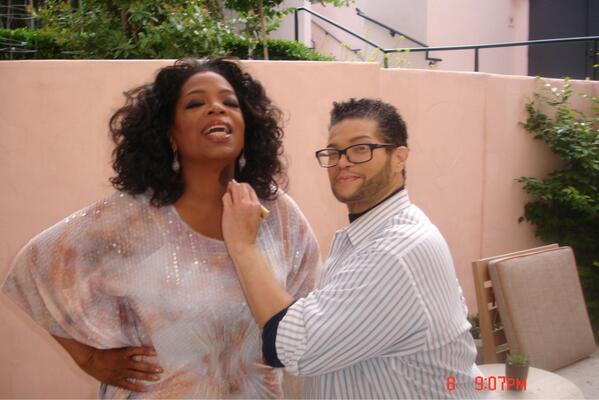
What products or tools were indispensable in the aging process?
I worked with prosthetic expert Matthew Mungle to age Oprah. Matthew created a mould out of Oprah’s face to make a silicone prosthetic. Once he put the prosthetic on, I would have to use alcohol and water-based make-up as cover up because oil-based make-up would make the prosthetics disintegrate. Usually I use a brush for foundation, in this case, had to use a sponge to apply the make-up to avoid tugging on the prosthetics. I also had to use a white pencil to match the eyebrows to her gray hair, penciling the eyebrows in and then using a brush to blend it all in. Lastly, Oprah had to wear contacts so that her eyes had the appearance of cataracts.
Of all the looks you had to create for Oprah, which one was the hardest to achieve, and why?
You would think that the older looks were hardest to create, but actually I found the younger looks to be more challenging. The reason for this is because when you first see Gloria in the movie it is during the 1950s when she is in her late 30s. Since Oprah is in her 50s, I needed to make her appear younger. I had to think about lifting her face to make it look tighter. This process required a lot of contouring, which can be a bit tricky when working in film, so I had to take my time. All the contouring was done with foundation and then it had to be well blended with a brush to give it a more natural finish. I also had to give Gloria darker brows because women wore them darker in the 1950s. As Gloria got older, I used less contouring and softened the brows.
Finding the right makeup for darker skin is difficult. Do you have any tips? What worked for Oprah – especially in terms of choosing the right foundation?
Working with Oprah presents some of the same challenges that most women of colour face, be it women of African, Indian, or South European decent. Most make-up lines create their foundations as if a woman’s complexion is all one colour. Women with darker skin tones have features that vary in undertones, from red, to blue, to yellow, and orange. What a woman needs to do is to learn how to identify her personal undertones, this way she can find a foundation that complements her skin. Foundation should enhance and not dull her complexion. What most companies do when formulating make-up for women of colour, is take foundations made for Caucasian women and simply add dark pigment to it. When applied, these types of products make darker skin tones look gray and ashy. I have created a patented make-up line that is a special formulation for the darkest to the lightest skin tones, which will be available in Canada in 2014, which I use on Oprah regularly.
Tell us a little bit about new your beauty line. What is the line's inspiration?
The main premise behind all my products is that health and beauty go hand in hand. I have always loved taking good care of my hair and skin. When I was growing up I would take household products such as oatmeal, lemon juice, avocado, cucumbers and played with essential oils to create my own home remedies that would benefit my hair and skin.
As an artist, I was always mixing products from other lines, combining them to achieve the right look for my clients, this led to my decision to create my own line. OOH Lifestyle is a comprehensive collection of hair, skin and make-up products. The first component of the line is called OOH Saloncare, now available in Canada and will be followed by my make-up line, which will be coming to market in 2014. Stay tuned on www.oohlifestyle.com, visit our Facebook page OOH Lifestyle, and follow us on twitter @OOHLifestyle @derrick4draf.
What products are you most excited to launch? Any innovations?
I am really excited about the OOH Saloncare line, which is now available in Canada. It is a very innovative product because it contains Naturalceuticals™. This is the medicinal approach of combining organic elements for the wellbeing and health of the human body. I worked with a team of chemists to re-invent conventional hair care and beauty products by embracing nature scientifically.
OOH Saloncare is a line of products designed for all hair types. The collection was formulated with botanical extracts, essential oils, fruit acids and other active ingredients that detoxify the scalp, oil glands and hair, and naturally restores the hair’s vitality, fullness and shine. Another key ingredient in the Saloncare line is glycolic acid, which conditions, strengthens, and protects hair from breaking.
Most importantly, will Oprah be using the line?
She wears my make-up now. I have customized a colour specifically for her as I have done for our First Lady Michelle Obama. As Ms. Winfrey said to the Washington Post, “What he has done is come up with a formula for brown girls. Esté©e Lauder, are you listening?”


